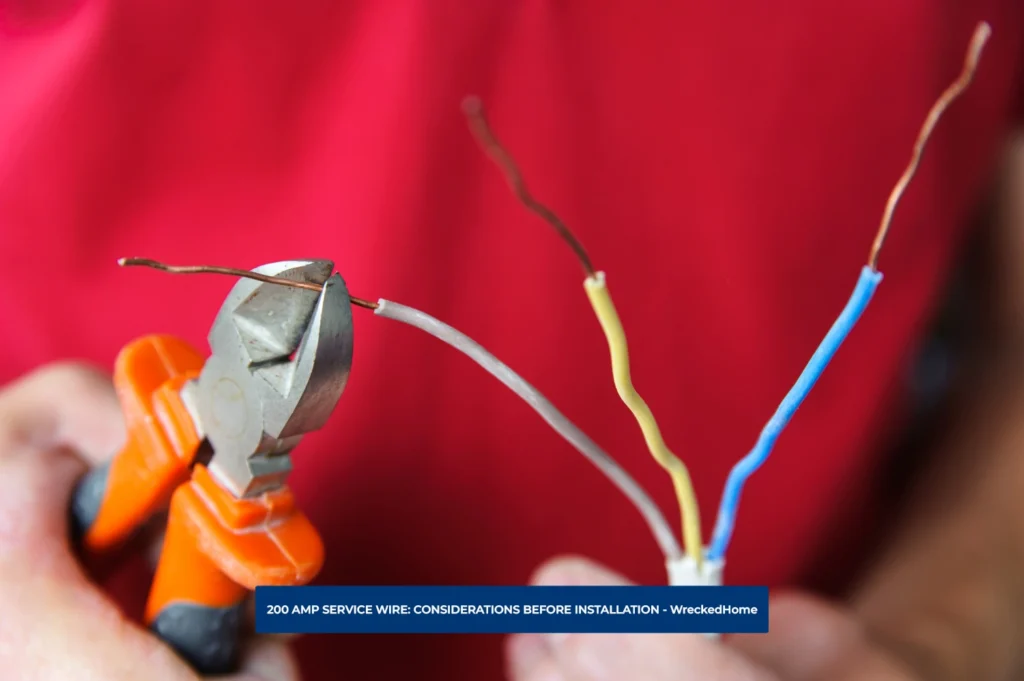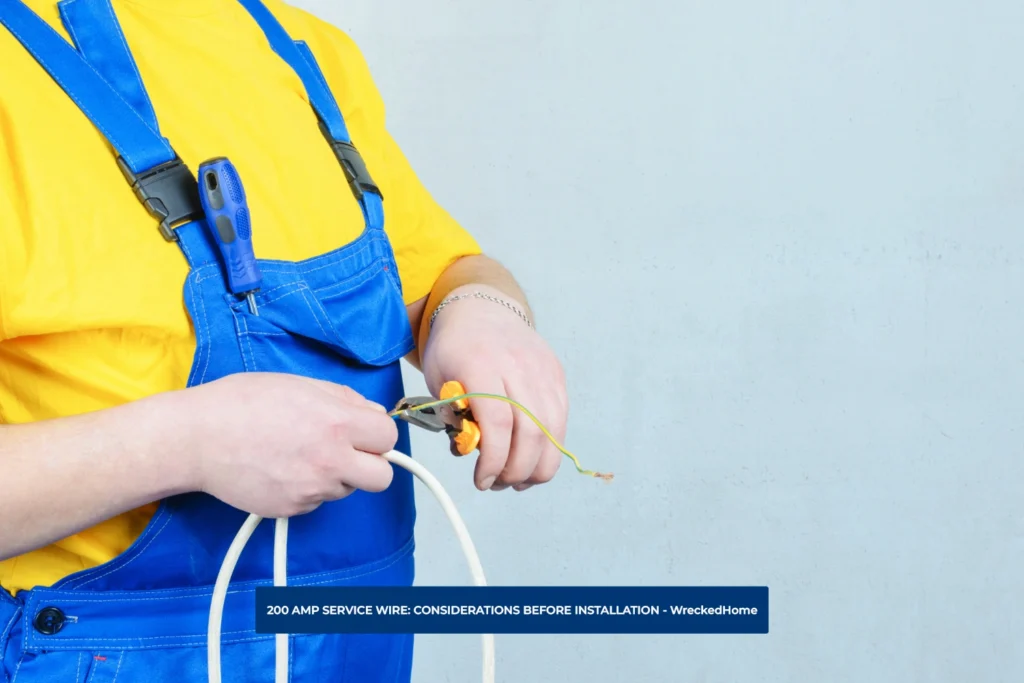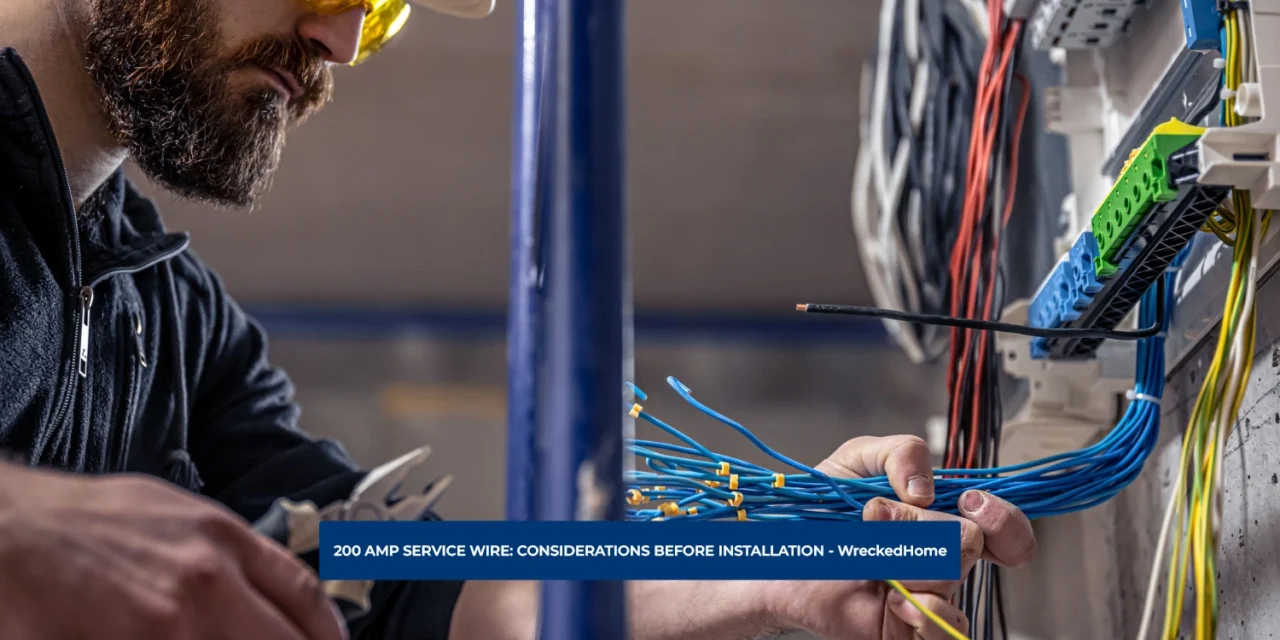Electrical service wires serve as the lifeline for modern structures because they deliver power to homes and offices. This intricate network of conductors play a crucial role in both residential and commercial settings to meet the demand for electricity.
Within this expansive realm, the 200 amp service wire offers a substantial capacity to meet the increasing demand for electricity. It has also surged with the arrival of advanced appliances, technology, and industrial machinery.
The 200-amp service wire emerges as a key player in addressing the solution to our increased power demand. Whether it’s powering multiple household appliances simultaneously or charging your electric vehicle, the 200-amp service wire stands as a linchpin for modern electrical systems.
With the increased need for the 200 amp service wire, the solution for a high electric need is helping homeowners, electricians, and business owners alike. In this article we will share important knowledge before you make the decision to install this type of service wire. First we will start by explaining they different types of wires that you can choose from. Let’s get started!
Copper vs. Aluminum Conductors (200 Amp Service Wire):

When it comes to selecting the right conductors for the 200 amp electrical wiring, copper and aluminum are two prominent options. Each material comes with its own set of advantages and drawbacks with their specific requirements and considerations. With proper skills and knowledge, users will better understand why one might choose copper or aluminum for their electrical installations.
Why Choose Copper Wiring (200 Amp Service Wire)?
Copper wiring stands as a premier choice in the realm of electrical installations that offer unparalleled conductivity to exceptional heat and corrosion resistance. With copper’s unique properties, its power transmission and system reliability are paramount in different applications.
- Conductivity: Copper’s claim to fame in the electrical world features low electrical resistance. Copper also ensures an efficient power transmission, which lowers energy loss during the journey from source to destination. This characteristic is especially crucial in high-performance electrical systems to meet the rapid power flow. Copper’s ability to conduct electricity with exceptional efficiency allow it to be best used in residential wiring as well as industrial power distribution.
- Heat Resistance: Beyond its exceptional conductivity, copper also has a heat resistant ability that makes it best in high temperature and high usage without the risk of deformation or damage. This heat-resistant quality is particularly advantageous in situations such as industrial settings or areas with high temperatures. The ability of copper to withstand heat helps to prevent from degradation or performance issues that may arise in less heat-resistant materials.
- Corrosion Resistance: Copper’s low reactivity rating makes it resistant to corrosion. Copper wiring is also really durable. Environments with exposure to moisture, humidity, or harsh conditions is a concern for corrosion. Copper prevents the formation of rust to increase its lifespan.
- Malleability: The malleability of copper is a distinctive characteristic that allows for easier bending and shaping during the installation process. So, wire cutting is a breeze with proper Wire Strippers. By facilitating the adaptation of copper wiring to the specific needs of a project, you ensure a smoother and more efficient installation process. The malleability of copper contributes to its versatility and allows it to meet spatial requirements without compromising its structural integrity.
Why Choose Aluminum (200 Amp Service Wire)?

Choosing aluminum wiring for the 200 amp wiring installation offers a range of advantages that make it a cost effective option for those who are budget conscious. Below we will discuss how those advantages.
- Lightweight: One of the most important features of aluminum wiring is its low weight. This is important when installation efficiency is a top priority. The reduced weight of the aluminum wire simplifies the logistics of transporting and maneuvering the wiring and facilitating a smoother installation process. This is particularly important in scenarios where large quantities of wiring are involved and when there is a need for a product that is light in weight.
- Cost-Effective: Cost considerations often play a pivotal role in electrical projects. The lower material cost of aluminum can significantly impact the budget-conscious endeavors. While copper may come with a higher upfront cost, aluminum’s cost-effectiveness make it a better choice in this department. This also makes aluminum an attractive option for various applications especially for larger projects when the budget is tight.
- Corrosion-Resistant: While not reaching the same level of corrosion resistance as copper, aluminum wiring can still withstand environmental challenges. By implementing proper protective measures like coatings or insulation, aluminum wiring can maintain its integrity over time to maintain structure for the long run.
Sizing for 200 Amp Service Wire
| 200-Amp Service Wire Size | Maximum Distance | Minimum Conduit Size |
| Copper 2/0 AWG | 50-feet | 1.5 inch |
| Copper 3/0 AWG | 100-feet | 2 inch |
| Copper 4/0 AWG | 150-feet | 2.5 inch |
| Aluminum 4/0 AWG | 50-feet | 1.5 inch |
| Aluminum 300 kcmil | 100-feet | 2 inch |
Key Considerations for Installation of 200 amp service wire
When it comes to electrical installations, the choice of wiring is important for safety and longevity. Below are some key tips for installing the 200 amp service wire.
1. Voltage Drop: Sizing Matters
Voltage drop is a critical consideration that impacts the performance of a system, especially over longer distances. The National Electrical Code (NEC) provides clear guidelines. For example, a 5% voltage drop should necessitate wire up-sizing.
With a 200-amp panel installation, the distance plays an important role. Electricians commonly employ a practice of adding 20% more amps for every 100 feet so that there will be no risk of voltage drop.
For instance, when dealing with a 200-amp panel situated 300 feet from the main service then the need for 300 MCM copper or 400 MCM aluminum is required as per NEC guidelines.
2. Conduit Selection: Above or Below Ground
Conduit selection is a critical aspect of the installation process that is based on the area of selection. Above-ground installations typically require flexible and rigid conduits, while underground applications mandate solid PVC options for best performance.
The choice between flexible and rigid conduits depends on factors such as the length of the run, wiring layout, and the specific requirements to ensure the correct conduit sizes and permits.
3. Cost Considerations: Balancing Expenses and Quality
The cost of materials, especially with the fluctuating prices of copper, contributes in the electrical installations. Shortages and disruptions in the supply chain lower the cost that may be tempted to undertake wiring projects.
Rising copper prices and potential shortages with a lower labor fee make it a cost-effective decision. While copper offers long term performance, the Aluminum offers an immediate low cost solution.
4. Type of Conduit for 200-Amp Conductors: Protecting the Wiring
Service entrance cables, especially those carrying 200 amp service wire loads, ensure the safety. For underground service, the NEC recommends a minimum of a 1.5-inch schedule 40 or 80 PVC conduit is suggested for smoother pulling.
5. Voltage Drop and the Impact of Length
Voltage drop is often explained as the decrease in voltage from the start to the end of the wire. It is due to fact that the larger length of wire increases resistance and subsequent drops in voltage. To counteract this, the wire gauge size must be increased, as recommended by the NEC to maintain 3%. Once you get to this amount, you will have less voltage drop. The choice between copper and aluminum wires further influences the gauge size for conductivity and heat resistance.
6. 1-Phase Versus 3-Phase: Efficiency and Amp Draw
For residential settings, 1-phase power is the normal option. However, in scenarios like wiring a shop with equipment for larger amp draws, a 3-phase power is the best choice. Three-phase power, with its three hot conductors, is more efficient for the same amperage. Coordinating three-phase power with the utility company is essential to ensure a seamless integration.
Because of this, the installation of 200-amp service wires requires careful attention and technical knowledge. Each decision, from wire selection to conduit choices, must meet the electrical standards and proper techniques for the demands of modern electrical consumption.
Conclusion (200 Amp Service Wire)
In conclusion, the choice between a 100-amp and 200-amp electrical service wire is a pivotal decision. This decision is based upon the safety and resilience of your home’s electrical system. The fundamental disparity lies in their respective capacities, with a 200 amp service wire being advantageous for high electric load areas.
On the other hand, the susceptibility of a 100-amp service to overload makes it less suitable. Frequent circuit breaker tripping and potential strain on the system require an efficient solution. In these areas, a 200-amp service provides ample capacity. It also meets the current needs and future expansions of high load spaces.
Collaborating with a skilled electrician is essential for your electrical demands. This further leads to a well-informed decision in the evolving landscape of electrical consumption. So it is important to better understand when to use copper or aluminum. Ultimately, investing in a 200 amp service wire not only enhances the reliability of your electrical infrastructure but also helps you in the ever-growing demands of the modern technological era.
Installation is intimidating. If you are not comfortable with installation, please hire a professional. Find A Pro Near You Here!
FAQs (200 Amp Service Wire)
What wire is needed for a 200 amp service?
For a 200 amp service wire installation, it is recommended to have at least 3/0 AWG copper or 4/0 AWG aluminum or aluminum copper-clad wire. The allowable capacity for 3/0 copper wire is 225 Amp, while 4/0 aluminum wire allows for 205 Amp, that ensure the efficient current transmission and safety.
Why is a 200 amp service necessary?
A 200-amp service wire is essential in meeting household needs. It provides the capacity for additional circuit breakers, reducing the risk of blown circuits and power outages. Upgrading to a 200 amp service wire is particularly crucial when you are using high power appliances.
Why is a 200 amp service better?
A 200-amp service surpasses its 100-amp counterpart due to high electricity consumption. The 100-amp can damage or reduce the likelihood of overloads, short circuits, and potential fires.
Is a 200 amp service normal?
Yes, the 200 amp service wire is standard for most homes, which are typically sufficient for the majority of residential settings. It caters to the diverse electrical needs of modern households without any distortion due to excessive load.





































